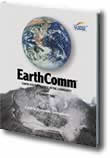Errata Notes on the 2001 Edition
Changes detailed below include both first printing errata and other changes made in subsequent printings to improve figures and the text.
- Page G8, line 2
40,000 km should be "80,000 km"
- Page G8, Figure 1
Figure 1 was modified to reflect more accurately dimensions of rifts and to identify the crust within the lithosphere. Figure (457 KB pdf).
- Page G9, Figure 2
The modified figure below includes distinctions between the different types of lithospheric plate boundaries and includes the names of several plates not labeled in the original rendering of Figure 2. Figure (343 KB pdf).
- Page G10, Figure 3 (also page G79, Figure 1)
The relative dimensions of the rift valley and the lithosphere were modified in this revised diagram. Figure (133 KB pdf).
- Page G10, line 7
Change "fluid" to "molten".
- Page G10 , first paragraph
Replace with, "In the United States, continental rifting long ago formed the rocks that make up the tall cliffs on the western bank of the Hudson River. These rocks formed when magma intruded the crust during this rifting. The rocks are seen for more than 80 km along the bank of the Hudson River and can be up to 300 m thick! Other evidence of magma formed during this rifting is found in many states along the East Coast."
- Page G11, line 23
Delete last sentence that begins with, "A seamount is a volcanic island…"
- Page G15, right column, line 10
Change "the Earth’s surface" to "sea level".
- Page G20, caption to Figure 5, line 2
Change "Ranier" to "Rainier".
- Page G28, lines 3-4
Delete the sentence “The ash falls to the ground downwind of the volcano.”
- Page G28, caption to Figure 4, line 2
Change to: "On the left side of the photograph, the dark region extending down the side of….."
- Page G83, Figure 4
Change "Mendecino" to "Mendocino".
- Page G87, photos at top of the page
Photos should be labeled as follows; left photo: sandstone; middle photo: granite; and right photo: basalt.
- Page G81, Figure 2
Figure 2 should reflect that melting is initiated in the asthenosphere above a subducted plate not in the subducted plate itself. Figure (143 KB pdf).
- Page G90, table, heading of second column
Delete the “s”
- Page G90, first full paragraph
Delete the second and last sentences. Add the following to the end of the paragraph: "The reason why the speed of seismic waves increases downward in the mantle is complicated. In the laboratory, scientists use special equipment to measure the speeds of seismic waves in different rocks. They can determine how the speed of seismic waves changes with changes in temperature, pressure, and rock type."
- Page G90, Figure 1
Change density for Continental crust to "~2.7" and Oceanic crust to "~3.0".
- Page G96, Figure
A legend is needed to indicate that triangles represent volcanoes and circles signify major earthquakes.
- Page G114, Figure 3
Change caption to read "The breakup of Pangea." In addition, the South American continent was inserted into the Figure 3 for the Cretaceous Period. Figure (459 KB pdf).
- Page G116, line 3
Change "paleolatitude" to "paleolongitude".
- Teacher's Edition, Page 341, test at end of chapter
Replace diagram used for questions 11-13 with this Figure showing data for GPS recording station CASA in California.
- Page G135, Interpreting Seismograms, line 12
Change "and along" to "(are reflected at)".
- Teacher's Edition, Page 498, End of Chapter Assessment
For question 9, responses c and d should be altered so that the answer key on page 500 remains correct.
The revised responses should be as follows:
c. A brick or masonry building constructed on solid bedrock.
d. A steel framed building constructed on solid bedrock.
extrusive igneous rock: an igneous rock that has formed by eruption of lava onto the surface of the Earth.
lava: molten rock that issues from a volcano or fissure.
mantle: the zone of the Earth below the crust and above the core.
map projections: the process of systematically transforming positions on the Earth's spherical surface to a flat map while maintaining spatial relationships.
seamount: a peaked or flat-topped underwater mountain rising from the ocean floor.
seismometer: an instrument that measures seismic waves. ...
silica: material with the composition SiO2.
subduction: replace the word "crust" with "lithosphere" in all three places in this definition.
tephra: a collective term for all the particles ejected from a volcano ...
tsunami: a great sea wave produced by a submarine earthquake (or volcanic eruption or landslide).
viscosity: the property of a fluid to offer internal resistance to flow.

